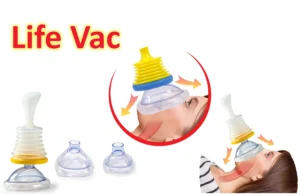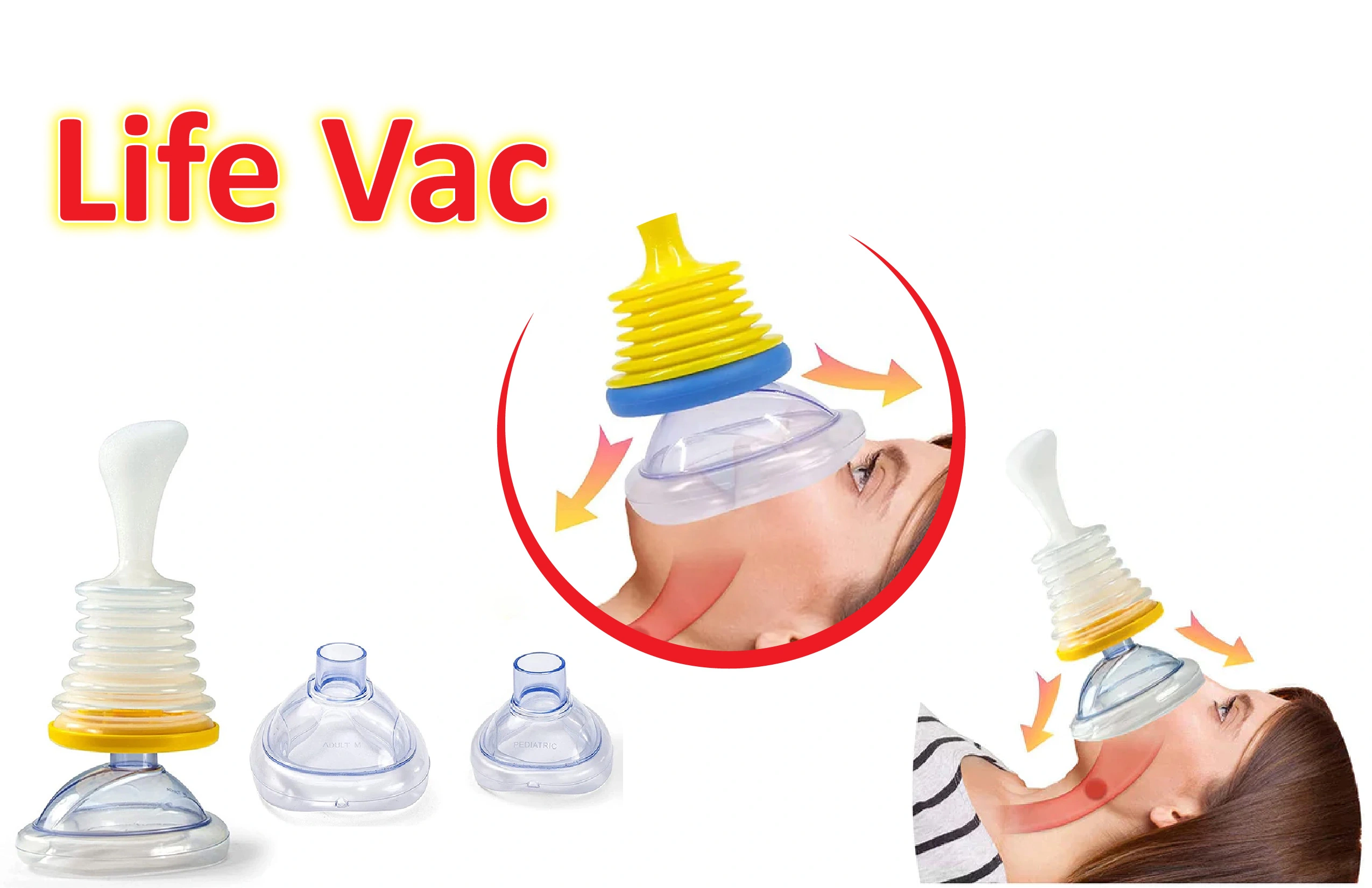1:Introduction of Life Vac
Life Vac is a life-saving medical device designed to quickly and safely remove obstructions from the airway of a choking victim. Its importance lies in its ability to act as a critical tool in emergencies, especially when conventional methods like the Heimlich manoeuvre are not practical or feasible. Simple to use and non-invasive, Life Vac is a vital addition to first aid resources, offering a swift solution to a potentially fatal situation, thus saving lives in choking emergencies.
2:What is Life Vac?
The Life Vac is an exceptional and groundbreaking device meticulously designed to meet the pressing demand for a highly efficient solution during choking emergencies. Its design and technology are simple yet revolutionary, making it a vital tool in emergencies. Here’s a breakdown of its design and technological aspects:
Design Features:
Simple Structure: Life Vac comprises a plunger-like apparatus, typically made of durable plastic. Its design is intuitive; the text you provided is clear and error-free. It reads: “making it easy for anyone to use, regardless of their strength or medical training.”
Facial Mask: Attached to the plunger is a facial mask designed to create a seal over the nose and mouth of the choking individual. This mask is crucial as it ensures the vacuum created is effective and targets the obstruction directly.
Non-Invasive Approach: Unlike other emergency procedures, the Life Vac is non-invasive. It does not require insertion into the throat, reducing the risk of additional injury.
Technology:
Vacuum Creation: The core of Life Vac’s technology: “The strength of this device lies in its capacity to generate a strong and regulated suction.”When the device is pushed down, the air is expelled, and pulling it back creates a vacuum. This vacuum force is what dislodges the obstruction from the airway.
One-Way Valve System: The device includes a one-way valve that prevents air from re-entering the mask on the downward push. This feature is crucial for maintaining the vacuum’s effectiveness.
Adjustable for Different Ages: Life Vac has different mask sizes to fit various age groups, from children to adults, ensuring the vacuum seal is effective and safe for other facial structures.
3 The Prevalence of Choking Hazards
Choking is a severe and often life-threatening emergency that can occur across all age groups, with the causes varying significantly based on age. Understanding these common causes is crucial for prevention and preparedness.
Infants and Toddlers (0-3 Years)
Food Items: Small, hard foods like nuts, seeds, popcorn, whole grapes, hard candies, and chunks of meat or cheese can be choking hazards. So, be careful while munching on your favorite snacks and take small bites to avoid any potential risk. Stay safe and enjoy your food.
Toys and Household Items: Small objects that can easily fit into a child’s mouth, such as marbles, small toy parts, coins, and batteries, pose a significant risk.
Eating Habits: Rapid eating, not chewing properly, or eating while distracted (like walking or playing) increases the risk of choking in this age group.
Young Children (4-10 Years)
Food Hazards: Similar to toddlers, foods like hot dogs, chewing gum, hard candy, and chunks of raw vegetables or fruits are common culprits.
Playful Behavior: Children in this age group often put objects in their mouths out of curiosity. Small household items or parts of toys still pose a risk.
Running and Playing: Eating while running, playing, or being overly active can lead to choking.
Adolescents and Adults (11 Years and Above)
Improperly Chewed Foods: Large bites of food, challenging “Meat, bread, and some types of fruits and vegetables are essential to add to the grocery list.” become lodged in the throat.
Alcohol Consumption: Intoxication can dull the reflexes and make it harder to chew and swallow properly, increasing the risk of choking.
Medical Conditions: Issues with dental health or conditions that affect swallowing (like neurological disorders) can make choking more likely.
Elderly
Dental Issues: Poor dentition or ill-fitting dentures can result in inadequate chewing of food.
Swallowing Disorders: Age-related changes in swallowing reflexes and conditions like stroke or dementia increase the risk.
Medications: Certain medications can affect saliva production, making the mouth dry and eating difficult.
Universal Causes
Talking or Laughing While Eating: This can inadvertently lead to inhaling food into the airway.
Rushed Eating: Eating too quickly without proper chewing increases the risk of choking.
Understanding these risks is vital for taking preventive measures, such as cutting food into smaller pieces for children, supervising meals, and ensuring that toys and household items are age-appropriate. Awareness and preparedness, including knowing how to use devices like the Life Vac, can significantly reduce the risk of choking incidents across all age groups.
4:Life Vac vs Traditional Methods
Comparing Life Vac with traditional choking relief methods, particularly the Heimlich maneuver, is essential to understanding their respective roles and effectiveness in emergencies. Each has its unique features and applications:

Life Vac
Method: Life Vac uses a suction device with a facial mask to create a vacuum, which dislodges the object, blocking the airway when the device is pulled upwards.
Non-Invasive: It does not require physical force against the person’s body, making it less invasive and reducing the risk of injury.
Ease of Use: Life Vac is designed to be straightforward to use by anyone, regardless of their physical strength or medical training.
Applicability: It benefits individuals who cannot receive abdominal thrusts, such as those who are obese, pregnant, in a wheelchair, or have certain medical conditions.
Safety: The risk of causing internal harm is lower than physical methods.
Traditional Methods (Heimlich Maneuver)
Mechanism: The Heimlich maneuver involves standing behind the person and using a series of upward abdominal thrusts to exert pressure on the diaphragm, dislodging the obstruction.
Physical Force Required: Requires physical strength and proper technique to be effective.
Limitations: Not suitable for certain groups like infants, the elderly, obese individuals, or pregnant women.
Risk of Injury: If performed incorrectly, it can cause injuries such as broken ribs or damage to internal organs.
Training Recommended: Proper training is advised to perform the maneuver effectively and safely.
Comparison and Context of Use
Effectiveness: Both methods can be effective in different scenarios. The Heimlich maneuver is widely recognized and recommended for an immediate response, while Life Vac provides an alternative when traditional methods are unsuitable or fail.
Complementarity: In some emergency scenarios, it’s advisable to try the Heimlich maneuver first (if safe and appropriate), and if unsuccessful, use Life Vac.
Accessibility and Training: Life Vac enhances accessibility, offering a solution for those unable to perform or receive the Heimlich maneuver effectively. Training in both methods is beneficial.
while the Heimlich maneuver remains a critical and widely used response to choking, Life Vac offers a complementary and sometimes necessary alternative for situations where traditional methods are not feasible. Understanding both ways and their appropriate application is essential in maximizing safety and preparedness in choking emergencies.
5:The Science Behind Life Vac
The effectiveness of Life Vac in addressing choking emergencies is rooted in fundamental medical and scientific principles related to air pressure and the human respiratory system. Here’s an explanation of these principles:
1. Air Pressure Differential
Vacuum Creation: Life Vac operates by creating a negative pressure, or vacuum, above the obstruction in the airway. When the device is pulled upwards, it generates a forceful suction.
Dislodging the Obstruction: This suction is designed to dislodge the object blocking the airway by overcoming the force with which it is lodged. The vacuum pulls the thing away from the airway walls and moves it upwards, clear of the throat.
2.Non-Invasive Technique
Safety Aspect: Unlike invasive procedures, Life Vac does not require insertion into the throat, minimizing the risk of further injury or complications, such as laryngospasm (spasm of the vocal cords) or damage to the airway structures.
3. Physiology of Choking
Airway Obstruction: Choking occurs when a foreign object blocks the trachea (windpipe), preventing air from reaching the lungs. The obstruction can be partial (allowing some air passage) or complete (no air passage).
Immediate Response: Quick removal of the obstruction is critical, as the brain can only survive for a few minutes without oxygen.
4. One-Size-Fits-All Design
Facial Masks: Life Vac comes with masks of different sizes, ensuring a proper seal over the nose and mouth for various age groups and face shapes. This adaptability is crucial for creating a practical vacuum.
5. Simplicity and Accessibility
Ease of Use: The design of Life Vac allows it to be used by individuals without medical training, making it a valuable tool in emergencies, particularly in locations where immediate professional medical assistance is unavailable.
6:Life Vac in Different Settings
With its versatility and ease of use, Life Vac is a valuable tool for managing choking emergencies in various settings. Its adaptability to different environments makes it a crucial addition to safety protocols across multiple venues:
1. Homes
Family Safety: In homes, especially those with children or elderly residents, Life Vac can be a critical part of emergency preparedness.
Accessibility: Keeping it in an easily accessible location ensures quick response during an emergency.
2.Schools
Protecting Students: Schools with a high concentration of young children more prone to choking can benefit significantly from having Life Vac devices.
Staff Training: Training school staff and older students on using the Life Vac can enhance safety measures.
3.Restaurants and Cafés
Customer Safety: Given the nature of these establishments, the risk of choking is higher. Having a Life Vac on-site provides an extra layer of safety for patrons.
Staff Preparedness: Training restaurant staff in using the Life Vac and traditional Heimlich maneuver training can be part of their emergency preparedness protocol.
4.Care Homes and Assisted Living Facilities
Elderly Care: Residents with age-related swallowing difficulties are at higher risk of choking in these facilities.
Staff Training: Equipping staff with the knowledge and tools like Life Vac can enhance resident safety.
5.Corporate Offices and Workplaces
Employee Safety: The inclusion of Life Vac in first aid kits and emergency protocols in workplaces can safeguard against potential choking incidents.
Awareness Programs: Conducting awareness and training sessions for employees can improve readiness in case of emergencies.
6.Public Venues and Event Spaces
Mass Gathering Safety: In places like theaters, stadiums, or convention centers, where there’s a large gathering of people, having Life Vac available can be part of comprehensive emergency medical planning.
7.Emergency and Medical Facilities
Complementary Tool: While these settings have professional medical equipment, Life Vac can be complementary, especially when traditional methods are not viable.
8.Travel and Transportation
On-the-Go Safety: Life Vac can be included in emergency kits on buses, trains, airplanes, and boats, providing a safety measure for passengers.
In each of these settings, the presence of Life Vac, combined with proper training in its use and regular drills, can significantly enhance safety and preparedness. It’s crucial that these settings not only equip themselves with Life Vac but also ensure that individuals are trained and comfortable with its use in an emergency.
7: Training and Awareness
Awareness and education play a pivotal role in preventing choking incidents, which are often sudden and unexpected. The key to reducing the frequency of these incidents lies in understanding the risks, recognizing the signs of choking, how to respond effectively. Here’s how awareness and education contribute to choking prevention:
Understanding Choking Hazards
Identifying Risks: Education helps individuals identify common choking hazards, such as certain foods (like grapes, nuts, and hard candy) and small objects, especially for vulnerable groups like children and older people.
Safe Practices: Awareness programs can teach safe eating practices (e.g., chewing food thoroughly, not talking or laughing while eating) and the importance of supervising young children during mealtime.
Recognizing Choking Signs
Early Intervention: Recognizing the signs of choking (like inability to speak, cough, or breathe, and signs of distress) enables quicker response, which can be lifesaving.
Differentiating Severity: Education can help distinguish between a mild and a severe choking incident, guiding whether to encourage coughing (benign) or take immediate action (extreme).
Training in Response Techniques
First Aid Skills: Training in first aid techniques, including the Heimlich maneuver and CPR, is vital. Adding training for devices like Life Vac further enhances preparedness.
Empowering Bystanders: Educating the public empowers bystanders to act effectively in emergencies, potentially saving lives before professional help arrives.
Implementing Safety Measures
Preventive Strategies: Awareness campaigns can encourage the implementation of safety measures in homes, schools, and public places (like having age-appropriate toys and cutting food into small pieces for children).
Policy and Procedure Development: In institutional settings, awareness can lead to developing safety policies and emergency response procedures, including the availability of choking response tools.
Regular Drills and Refreshers
Maintaining Skills: Regular practice and refreshers of emergency response techniques ensure that individuals remain confident and competent in responding to choking incidents.
Role of Media and Technology
Widespread Outreach: Utilizing media and technology (like social media, apps, and online courses) can help disseminate information widely and efficiently.
Interactive Learning: Interactive tools and simulations can enhance learning and retention of choking prevention and response techniques.
The importance of awareness and education in preventing choking incidents cannot be overstated. It creates a knowledgeable and prepared community, reduces the risk of choking, and enhances the response’s effectiveness when incidents occur. This collective knowledge and preparedness can significantly reduce the injuries and fatalities caused by clogging.
8: Life Vac for Children and Special Needs
The application of Life Vac for children and individuals with special needs is particularly noteworthy, as these groups often require specific considerations when it comes to emergency response, including choking incidents.
Application for Children
Age-Appropriate Design: Life Vac has various mask sizes, ensuring a proper and secure fit for children. This adaptability is crucial because an adequate seal is necessary for the vacuum to work.
Gentle Yet Effective: The device is designed to be gentle enough for use on small, delicate bodies yet effective enough to dislodge an obstruction from the airway.
Non-Invasive: Unlike some traditional methods, Life Vac is non-invasive. This feature is essential for children who might be scared or resistant to other forms of intervention.
Ease of Use: In a high-stress situation, such as a child choking, the simplicity of Life Vac can be a significant advantage, allowing a caregiver or bystander to act quickly and efficiently.
Application for Individuals with Special Needs
Adaptability: For individuals with physical or neurological disabilities, traditional choking response techniques like the Heimlich maneuver may not be feasible. Life Vac’s design allows for use in various positions and circumstances, accommodating different physical needs.
Safety for Fragile Individuals: People with certain medical conditions (like osteoporosis) or those who are bedridden can benefit from Life Vac’s non-intrusive nature, which minimizes the risk of physical injury from traditional choking response methods.
Autonomy and Empowerment: For individuals with special needs who strive for independence, knowing that Life Vac is available can offer a sense of security. It can be used by the individual or a caregiver with minimal training.
Training and Education: Caregivers, family members, and healthcare professionals working with children and special needs populations need training on using Life Vac. This training should be a part of their broader emergency response education.
Compliance with Regulations: For institutions that cater to children and individuals with special needs, such as schools, care homes, and therapy centers, having a Life Vac device can comply with health and safety regulations, emphasizing their commitment to the safety and well-being of their populations.
Life Vac’s versatility, ease of use, and safety profile make it invaluable for providing emergency aid in choking incidents, particularly for children and individuals with special needs. This accessibility and effectiveness can significantly affect these vulnerable groups’ emergency situations.
9: Innovations and Future Developments
Exploring recent innovations and potential future improvements in Life Vac technology reveals a dynamic field focused on enhancing safety and effectiveness in choking emergencies. While my knowledge is current until April 2023, I can speculate on potential directions for innovation and improvement based on existing trends and technological advancements.
Recent Innovations in Life Vac Technology
Enhanced Mask Design: Recent developments may include improvements in the facial mask design, making it more adaptable to different face shapes and sizes, ensuring a better seal and more effective suction.
Material Advancements: Using more durable, lightweight, and biocompatible materials could improve the device’s usability and longevity.
Integrated Feedback Mechanisms: Incorporating sensors that provide feedback on the suction strength or correct mask placement could enhance the device’s effectiveness and safety.
Compact and Portable Versions: Innovations in design that make the device more compact and portable would be beneficial, especially for personal carry in public places, travel, and remote areas.
Potential Future Improvements
Smart Technology Integration: Future versions of Life Vac might include innovative technology, such as connectivity with smartphones or healthcare systems, to provide instant.
10: FAQs about Life Vac and Misconceptions
Addressing common questions and misconceptions about Life Vac is crucial for ensuring proper understanding and usage of this life-saving device. Here are some frequently asked questions and myths, along with accurate information:
Common Questions
How does Life Vac work?
Life Vac uses suction to dislodge an object from a person’s airway. When the device is placed over the mouth and nose and the handle is pulled, it creates a vacuum that helps remove the obstruction.
Is Life Vac safe to use?
Yes, Life Vac is designed to be safe. It’s non-invasive and doesn’t require insertion into the throat, minimizing the risk of injury.
Can anyone use Life Vac, or is training required?
Life Vac is designed to be easy for everyone, even those without medical training. However, familiarizing yourself with the instructions and proper usage is recommended.
Is Life Vac effective for all ages?
Life Vac has different sizes of masks, making it suitable for use across various age groups, from children to adults.
Misconceptions
“Life Vac can replace CPR or the Heimlich maneuver.”
Misconception: Life Vac is intended as a complementary tool, not a replacement for traditional choking response techniques like CPR or the Heimlich maneuver. It’s often used when these methods could be more practical and feasible.
“Life Vac can cause harm if misused.”
Life Vac is designed to minimize harm; any medical device should be used correctly. Its non-invasive nature reduces the risk of injury associated with invasive techniques.
“Life Vac is only for medical professionals.”
Life Vac is designed for both professional and layperson use. Its simplicity makes it accessible in homes, schools, restaurants, and other non-medical settings.
“Life Vac is a complicated device.”
Life Vac is relatively straightforward to use. The device consists of a suction unit and a face mask, and it operates on the simple principle of creating a vacuum to dislodge an obstruction.
“Using Life Vac can delay emergency services.”
Life Vac is a tool for immediate response in choking emergencies. It is not meant to replace calling emergency services, which should be done as soon as a choking incident occurs.
By addressing these questions and misconceptions, users can better understand Life Vac’sVac’s role, capabilities, and limitations, ensuring it is used effectively and safely in choking emergencies.
Conclusion
Life Vac represents a significant advancement in emergency response to choking incidents. Its simple, safe, and practical design makes it an invaluable addition to safety protocols in various settings, offering peace of mind and the potential to save lives.





Leave a Reply